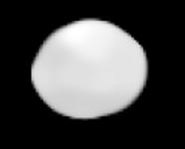 | |
| Discovery | |
|---|---|
| Discovered by | J. Ferguson |
| Discovery date | September 1, 1854 |
| Designations | |
| (31) Euphrosyne | |
| Pronunciation | /juːˈfrɒsɪniː/[1] |
Named after | Εὐφροσύνη Eyphrosynē |
| A907 GP; A918 GB | |
| Main belt | |
| Adjectives | Euphrosynean /juːfrɒsɪˈniːən/[2] |
| Orbital characteristics[3] | |
| Epoch April 27, 2019 (JD 2458600.5) | |
| Aphelion | 3.8523 AU (576.296 Gm) |
| Perihelion | 2.4585 AU (367.786 Gm) |
| 3.1554 AU (472.041 Gm) | |
| Eccentricity | 0.2209 |
| 5.61 yr (2041.585 d) | |
| 87.1671° | |
| Inclination | 26.3033° |
| 31.1186° | |
| 61.4704° | |
| Known satellites | 1 |
| Physical characteristics | |
| Dimensions | c/a = 0.86±0.07[4] (294±6) × (280±10) × (248±6) km[5] |
| 268±4 km[4] 267.1±2.6 km (IRAS)[3] 268±6 km[5] | |
| Mass | (16.5±2.6)×1018 kg[4] (17±3)×1018 kg[5] |
Mean density | 1.64±0.27 g/cm3[4] 1.66±0.24 g/cm3[5] |
| 0.230400 d (5.529595 h)[5] | |
| 0.05[4] 0.0543[6] | |
| C[3][7] | |
| 10.16[8] to 13.61 | |
| 6.74[3] | |
31 Euphrosyne is a very young asteroid. It is one of the largest asteroids (approximately tied for 7th place, to within measurement uncertainties). It was discovered by James Ferguson on September 1, 1854, the first asteroid found from North America. It is named after Euphrosyne, one of the Charites in Greek mythology. In 2019 a small companion was discovered. It is the third-roundest known asteroid (after 1 Ceres and 10 Hygiea); this is thought to be due to having re-accreted after being disrupted by a collision, and it is not close to hydrostatic equilibrium.[5]
- ^ Noah Webster (1884) A Practical Dictionary of the English Language
- ^ "Elia", The New-England Magazine, vol. IX, Oct. 1835, p. 236
- ^ a b c d Cite error: The named reference
jpldatawas invoked but never defined (see the help page). - ^ a b c d e P. Vernazza et al. (2021) VLT/SPHERE imaging survey of the largest main-belt asteroids: Final results and synthesis. Astronomy & Astrophysics 54, A56
- ^ a b c d e f Cite error: The named reference
Yang2020was invoked but never defined (see the help page). - ^ "Albedo table". Archived from the original on 22 July 2012. Retrieved 27 December 2006.
- ^ "Astrometric and Geodetic Properties of Earth and the Solar System" (PDF). Archived from the original (PDF) on 7 July 2009. Retrieved 6 August 2007.
- ^ "Bright Minor Planets 2000". Minor Planet Center. Retrieved 23 May 2008.[permanent dead link]